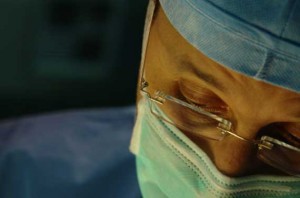Keep 24-hour phone numbers handy. Call your surgeon’s office if you feel you are not healing properly. You or a family member should check your incision every day. If you think you have a fever take your temperature.
Lumbar Spinal Fusion: Definition
Lumbar spinal fusion is a surgical procedure that involves placing hardware, such as screws or rods, in or around spinal vertebrae to steady or fix (fuse) the spine. Sometimes this procedure is needed because of severe and/or chronic back pain and sometimes due to an injury.
Lumbar refers to the lower portion of your back and spinal column (between your rib cage and hip bones). The parts of the spinal column from top to bottom are: cervical (neck), thoracic (rib cage), lumbar, sacrum, and coccyx (tailbone).
Each vertebrae is labeled with a number that corresponds to its position (also from top to bottom). So you have cervical (neck) vertebrae from 1-7 (C1, C2, C3…C7); thoracic (rib cage) vertebrae 1-12 (T1..T12); and lumbar vertebrae 1-5 (L1…L5). The sacrum includes five fused vertebrae and the coccyx includes four.
When there is inflammation, injury, or pain that surrounds a certain portion of the spinal cord or vertebrae, a specialist is consulted to assess and evaluate the condition of the spine. This type of doctor is called a neurologist (and then perhaps a neurosurgeon or orthopedic spine surgeon).
Lumbar Spine Structure and Function
Pain and swelling after spinal fusion surgery
It is important to care for yourself while you are recovering from lumbar fusion surgery. Follow your doctors’ instructions on activity, self care, and wound care.
Want to prevent swelling and pain after spinal fusion surgery? Try these tips:
Ice your back for 20-30 minutes, 4 times per day.
- Place a towel over your incision site, then place an ice pack or gel/ice pack on top for 20-30 minutes.
- Afterward, remove the towel and ice. Re-freeze your ice pack so it is ready to use again.
- Repeat four times per day (or every 6 hours).
- Do not ice for more than 30 minutes as this could increase your pain.
Get moving.
- While it is important to rest and take it slow, finding regular times to walk for a bit will help to increase circulation and thus promote healing and decrease swelling.
- If an activity causes you pain, stop immediately.
- While you are in the early stages of healing, try to at least change your position every 20-30 minutes.
- Every 1 1/2 -2 hours get up and walk for about 2-10 minutes (or as tolerated or recommended by your physician).
- Walking helps strengthen legs, promote healing, decrease the chance of swollen feet after spinal surgery and decrease the chance of developing blood clots. Walking also helps prevent constipation.
Eat healthy and drink lots of water.
- Eating well and staying hydrated helps with healing, decreases swelling, and decreases constipation.
Keep your incision clean and dry.
- Keep your incision site open to air (unless you have drainage or have been instructed to keep it covered by your doctor).
- Wash it in the shower (do not soak in a bath) once per day with soap and water.
- Pat dry with a clean dry towel.
Lumbar Spinal Fusion Surgery: What you need to know and watch for during recovery
As with any surgical procedure, complications related to infection, bleeding or anesthesia may occur. You may find the following lists helpful in knowing when to call your doctor or spine surgeon while recovering from lumbar spinal fusion surgery.
If you have any of the following signs of infection or other complications, call your surgeon right away.
Signs of infection include
- Red, hot, swollen incision
- Chills or a fever of over 100.4°F
- Foul smelling discharge coming from your incision
- Yellow/green colored discharge from your incision
- Incision swelling and/or redness after spinal fusion
Other complications of spinal fusion surgery or lumbar fusion may include:
- Formation of blood clots
- Nerve damage
- Pseudoarthrosis (the vertebrae do not fuse together after surgery like expected)
- Hardware (such as screws, rods, or cages) may break and/or become loose
- Bleeding
Signs and symptoms of other complications include
The following are other signs and symptoms of a variety of different complications (mentioned above) that you could experience after a spinal or lumbar fusion surgery. If you experience any of the following, it may indicate a complication and you should call your doctor or spine surgeon immediately.
- Back swelling and/or severe pain after spinal fusion that does not go away with your pain medication
- Swelling of feet and/or hands after spinal fusion surgery
- Chest pain after spinal fusion surgery
- Chest congestion, coughing, or problems breathing while at rest
- Leg pain after lumbar fusion surgery, especially pain and/or redness in the calf (possibly indicative of blood clot)
- Inability to control bladder or bowels
- A bulge in your back
- You cannot move your arms or legs
- You have new numbness, tingling or weakness in your arms, hands, fingers, legs, feet or toes
- Sudden increase or new appearance of bruising, especially around incision site
- The edges of your incision start to separate or come apart
Note that the information in this article is purely informative and should not be used in place of recommendations from your surgical team.
Related Articles
Lumbar Spinal Fusion
Most Common Causes of Lumbar Back Pain
Your Visit With The Surgeon
Getting Yourself Ready For Surgery
Understanding Back Precautions
Making Arrangements For Surgery
Your Hospital Visit
Lumbar Spinal Fusion Surgery
Recovery At Home
When To Call Your Surgeon
Long Term Care For Your Back

